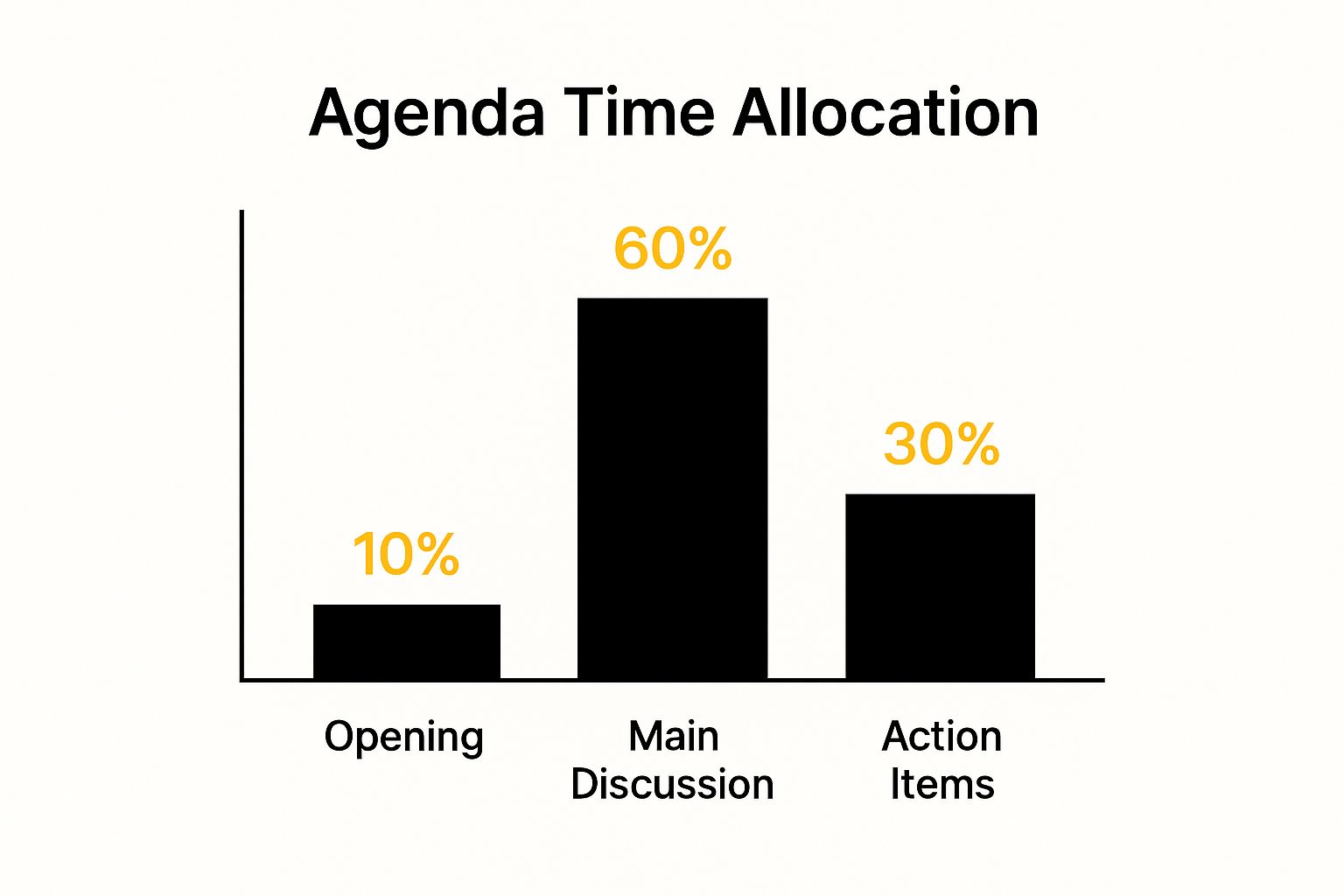Why Most Meetings Fail (And How Templates Fix Everything)

Let’s be honest: a lot of meetings are unproductive. They frequently lack direction, clear goals, and structure, leaving attendees feeling frustrated and disengaged. This unproductive atmosphere wastes time and leads to missed opportunities. Ultimately, organizations lose valuable resources and limit their potential for growth and innovation. A simple meeting agenda template can be the solution to a more productive meeting culture.
The Downward Spiral of Unstructured Meetings
Imagine a meeting where the conversation wanders off-topic, participants interrupt each other, and no decisions are made. This, unfortunately, happens all too often. Without a pre-planned agenda, meetings easily become unproductive, wasting everyone’s time.
A lack of structure also creates confusion about roles and responsibilities, hindering progress on important projects. This disorganization contributes to employee disengagement and lowers morale as people feel their time isn’t valued.
For example, consider a project kick-off meeting without an agenda. Key stakeholders may not agree on objectives, timelines, or individual contributions. This initial misalignment can set the project up for failure from the start. Without clear action items, accountability is blurred, making it difficult to track progress and address roadblocks. Learn more in our article about How to master effective daily stand-up meetings.
The Power of Simple Meeting Agenda Templates
This is where the simple meeting agenda template makes a difference. By providing a clear roadmap for the discussion, a template ensures that everyone is on the same page. A well-structured agenda outlines the key topics, allocates specific time slots for each item, and defines the desired outcomes.
This structured approach streamlines the discussion, keeps participants focused, and helps make decisions more efficiently. Surprisingly few meetings actually use this valuable tool. Only 37% of workplace meetings use meeting agendas, meaning most proceed without a formal plan. Even more concerning, 64% of recurring meetings have no agenda at all. Find more detailed statistics here.
Simply having a template isn’t enough, however. The key is to create an agenda specific to the meeting’s purpose. A project update meeting will have a different structure than a brainstorming session. By carefully considering the objectives and desired outcomes of each meeting, you can create an agenda that maximizes productivity and drives meaningful results. This simple change in planning can transform dreaded meetings into productive collaboration sessions.
The Hidden Cost of Meeting Overload (Your Wake-Up Call)

Many organizations today face the challenge of meeting overload. This occurs when excessive time is spent in meetings, negatively impacting productivity and employee well-being. Instead of fostering collaboration, these excessive meetings often diminish its value and prevent employees from focusing on important tasks.
The Drain on Productivity and Morale
The constant context switching required by back-to-back meetings disrupts workflow and makes it challenging to concentrate on deep, focused work. This can lead to a backlog of tasks, increased stress, and a significant drop in overall productivity.
Meeting overload also takes a toll on employee morale. When employees feel their time is dominated by meetings, leaving little room for the work they were hired to do, job satisfaction can plummet. This can contribute to burnout, frustration, and ultimately, increased employee turnover. For more insights into workplace challenges, you might find this article helpful: Why Agile Fails.
The numbers paint a stark picture: employees spend an average of 392 hours per year in meetings. This translates to nearly 10 full workweeks spent solely in meetings. The situation is even more pronounced for managers. In 2023, managers spent over 50% of their workweek in meetings, a significant 66% increase compared to previous years. Learn more about these statistics.
Stifling Creativity and Strategic Thinking
Beyond the immediate effects on productivity and morale, meeting overload also hampers long-term organizational success. Excessive meetings leave little time for crucial activities like creative thinking and strategic planning.
These activities require dedicated time for reflection and in-depth analysis, both of which are difficult to achieve when calendars are constantly filled with meetings. This constant state of reactivity stifles innovation and can prevent organizations from effectively adapting to market changes.
Breaking the Cycle With Simple Meeting Agenda Templates
Fortunately, there’s a practical solution to combat meeting overload: simple meeting agenda templates. By using clear, concise agendas, organizations can significantly reduce meeting time and improve overall effectiveness.
A well-defined meeting agenda template ensures every meeting has a clear purpose, specific objectives, and a structured flow. This helps prevent meetings from veering off-topic or running longer than necessary. The result? More time for focused work, a boost in productivity, and a more positive work environment. A well-structured agenda truly is the key to efficient and productive meetings.
Anatomy Of A Perfect Simple Meeting Agenda Template
Creating effective meeting agendas doesn’t require advanced project management skills. This section breaks down the essential components of a simple meeting agenda template and how it can transform your meetings from time-wasters into powerful productivity boosters. We’ll explore proven agenda structures, the psychology of time allocation, and how to build momentum that keeps everyone engaged.
Essential Components of a Simple Meeting Agenda Template
A well-structured simple meeting agenda template provides a clear roadmap for your meeting. Think of it as a GPS for your discussion, ensuring everyone stays on track and arrives at the intended destination efficiently. This begins with allocating the right amount of time for each section. The following infographic visualizes an effective breakdown of typical meeting time allocation:

This infographic shows that the majority of the meeting time (60%) should be for the main discussion. Opening remarks and action items should take less time (10% and 30%, respectively). This balance allows enough time to address key issues while ensuring efficient starts and finishes.
The following table provides a more detailed breakdown of the components of a meeting agenda:
To help illustrate these components further, let’s look at a breakdown in a table format:
Essential Meeting Agenda Template Components: Breakdown of time allocation and purpose for each agenda section.
| Agenda Section | Time Allocation | Purpose | Key Outcomes |
|---|---|---|---|
| Meeting Title/Objective | Included in header | Clearly states the meeting’s purpose. | Participants understand the focus and can prepare. |
| Date and Time | Included in header | Essential for record-keeping and scheduling. | No scheduling conflicts, easy reference for minutes. |
| Attendees | Included in header | Lists all participants. | Everyone knows who is involved and can address relevant parties. |
| Agenda Items | Variable, depends on meeting length | Outline the specific topics to be discussed. | Provides structure and keeps the discussion focused. |
| Time Allotment | Specified per agenda item | Allocates a time frame for each item. | Ensures efficient use of meeting time. |
| Action Items | Variable, typically towards the end | Defines tasks to be completed after the meeting, assigns responsibility, and sets deadlines. | Promotes follow-through and accountability. |
This table clarifies the purpose and desired outcomes of each section, making it easier to create an effective agenda. By understanding these components, you can craft a template tailored to your specific meeting needs.
Structuring Your Agenda for Maximum Impact
The order of your agenda items can significantly affect meeting effectiveness. Starting with a quick review of the previous meeting’s action items promotes accountability and starts the meeting productively. This also provides an opportunity to handle outstanding issues before moving on to new topics.
Smooth transitions between agenda items are essential for maintaining momentum. Clear transitions signal topic shifts and prevent disjointed discussions. This can be as simple as summarizing the previous point before introducing the next.
Concluding with action items and next steps reinforces the discussion and ensures everyone leaves with a clear understanding of their responsibilities. This also promotes follow-through and accountability. Using these techniques transforms a simple meeting agenda template into a powerful tool for achieving meeting objectives and maximizing productivity. A common example of a simple meeting agenda template includes sections like ‘Welcome and Introductions’ (5 minutes), ‘Review of Last Meeting’s Action Items’ (10 minutes), ‘Progress Updates on Ongoing Projects’ (15 minutes), ‘Discussion on New Business’ (20 minutes), and ‘Action Items and Assignments’ (10 minutes), followed by ‘Closing Remarks’ (5 minutes). You can explore further tips and templates on Smartsuite.
Ready-To-Use Templates For Every Meeting Type
Different meetings call for different strategies. However, the core elements of a simple meeting agenda template remain consistent. This section offers proven agenda frameworks for a variety of meeting scenarios, from quick daily stand-ups to comprehensive quarterly reviews. We’ll also explore how to tailor these templates for brainstorming, problem-solving, decision-making, and status updates.
Daily Stand-Up Meeting Template
Daily stand-ups are designed for quick updates and identifying roadblocks. These meetings should be kept short and focused. A simple meeting agenda template for a daily stand-up could include:
- Yesterday’s accomplishments
- Today’s plan
- Roadblocks or challenges
This template ensures everyone is on the same page regarding the team’s progress and any obstacles. For teams using Scrum, this template can be easily modified to align with the standard “What did you do yesterday? What will you do today? Any impediments?” You might find this helpful: Our essential guide to Scrum meetings.
Problem-Solving Meeting Template
Problem-solving meetings demand a more structured format. A simple meeting agenda template for this type of meeting might include:
- Problem definition and scope
- Brainstorming potential solutions
- Evaluating solutions and selecting the optimal choice
- Action plan and next steps
This framework guides teams through a systematic process of addressing challenges and developing actionable solutions. It ensures that the conversation remains centered on the problem at hand and fosters collaboration toward a solution.
Decision-Making Meeting Template
Decision-making meetings are most effective with a clear presentation of options and criteria. A simple meeting agenda template could be structured as follows:
- Review the decision to be made
- Discuss the criteria for evaluation
- Present and evaluate each option
- Make the decision and document it
- Action plan for implementation
This template helps ensure thoughtful decisions based on a clear understanding of the available options and their potential impact. The structured approach minimizes the risk of impulsive or uninformed choices.
Adapting Templates to Your Needs
These templates provide a strong foundation, but it’s important to remember that they are simply starting points. Adapting them to your specific needs is essential. Consider factors such as meeting duration, team size, and company culture.
For example, a 30-minute meeting will require a more concise agenda than a 2-hour session. Likewise, a larger team may require additional time for discussion and brainstorming. Modifying the templates based on these factors keeps them useful for productive and effective meetings. Even small adjustments can significantly improve meeting productivity.
To help visualize the differences, let’s look at a comparison:
Meeting Type Template Comparison: Comparison of different agenda templates based on meeting type and duration
| Meeting Type | Duration | Key Sections | Best For |
|---|---|---|---|
| Daily Stand-up | 15 minutes | Yesterday’s accomplishments, Today’s plan, Roadblocks | Quick status updates and identifying obstacles |
| Problem-Solving | 60-90 minutes | Problem definition, Brainstorming solutions, Evaluating options, Action plan | Addressing specific challenges and finding solutions |
| Decision-Making | 60-120 minutes | Review decision, Evaluation criteria, Presenting options, Making the decision, Action plan | Making informed decisions based on defined criteria |
This table summarizes the key differences between various meeting types and how agenda templates can be adjusted for each. By tailoring your approach to the specific meeting objectives, you can maximize productivity and achieve better outcomes.
Implementation Strategies That Actually Work

Having well-designed simple meeting agenda templates is a crucial first step. However, real success lies in effective implementation. This requires a strategic approach, consistent team effort, and smart change management. This section explores practical strategies to smoothly introduce these templates, minimizing resistance and administrative overhead.
Getting Buy-In and Overcoming Resistance
Introducing new processes can sometimes be met with skepticism. To effectively implement simple meeting agenda templates, clearly communicate the benefits to your team. Explain how these templates will sharpen meeting focus, minimize wasted time, and boost overall productivity.
Proactively addressing potential concerns is also important. Acknowledge that change takes time. Offer support to team members who may be hesitant. For example, provide training on using the templates and create opportunities for feedback and adjustments.
Involving team members in selecting and customizing templates is also beneficial. This sense of ownership can greatly increase buy-in and encourage adoption. Successful implementation relies on collaboration and a shared understanding of the goals.
Building Sustainable Habits
Consistency is key to integrating simple meeting agenda templates into your meeting culture. Make agendas a required element of every meeting. This sets a clear expectation and reinforces the value of structured discussions.
Regularly reviewing and refining your agenda process is essential. What works for one team may not work for another. Experiment with different formats and gather feedback. Ensure the templates meet your team’s specific needs. This ongoing evaluation is vital for establishing sustainable habits. For more on effective meetings, check out this article on stand-up meetings. A well-structured crisis communication plan is also essential for handling unexpected disruptions.
Tracking Progress and Ensuring Accountability
Measuring the impact of your efforts provides valuable data. Track key metrics such as meeting duration, action item completion rates, and team satisfaction scores. This data provides concrete evidence of the templates’ effectiveness and highlights areas for improvement. Teams using structured meeting agenda templates often report a 73% increase in meeting satisfaction and a 45% decrease in average meeting length while maintaining or improving decision quality and action item follow-through. For more on successful meeting implementation, see this resource.
To ensure consistent agenda use, create accountability systems. Assign someone to create and distribute agendas before each meeting. Incorporate agenda review into meeting follow-up procedures. These systems reinforce the importance of agendas and integrate them into your team’s routine, preventing them from being seen as extra work. This proactive approach transforms simple meeting agenda templates from a new idea into a vital part of your meeting culture.
Key Takeaways
Transforming your meeting culture begins with understanding effective meeting principles and the significant role of simple meeting agendas. This section distills the article’s key takeaways into actionable steps for immediate implementation, focusing on practical advice, checklists, and strategies for a productive and collaborative meeting culture.
The High Cost of Poorly Planned Meetings
A crucial takeaway is recognizing the hidden costs of poorly planned meetings. These extend beyond wasted time to include diminished productivity, disengaged employees, and lost opportunities. Without a defined purpose and structure, meetings drain resources instead of driving results. Implementing simple meeting agenda templates is a critical first step. This establishes a clear structure and defined objectives, maximizing efficiency and impact.
The Power of the Simple Meeting Agenda Template
The simple meeting agenda template is a powerful tool. It provides a roadmap for discussion, maintains participant focus, and promotes efficient decision-making. Remember to tailor agendas to each meeting’s purpose. A project update meeting needs a different structure than a brainstorming session. For example, check out our guide on How to master retrospectives for more insights on tailoring your approach.
Building a Culture of Effective Meetings
Effective implementation goes beyond creating templates. It requires a strategic approach to building a culture that values and consistently uses agendas. This involves team buy-in, overcoming resistance to change, and establishing accountability. To further streamline team meetings, consider using a dedicated platform for scheduling and organization. Book A Meeting may be a helpful resource.
Key Elements for Meeting Success
- Clear Objectives: Define the purpose of each meeting, ensuring all attendees understand it. This shared understanding maintains focus and productivity.
- Structured Agenda: Use a simple meeting agenda template tailored to the meeting’s purpose. This provides a roadmap and helps manage time.
- Action Items and Follow-Up: Conclude each meeting with clear action items, assigned owners, and deadlines. This promotes accountability and follow-through.
- Continuous Improvement: Regularly evaluate your meeting process and gather participant feedback. This iterative approach ensures continuous improvement.
Warning Signs and Benchmarks
Recognizing warning signs of ineffective meetings is crucial for adjustments. Indicators include frequent off-topic discussions, a lack of clear decisions, and consistently exceeding allotted time. Benchmarks for success include increased meeting satisfaction, reduced meeting duration, and improved action item completion rates. Tracking these metrics helps measure your efforts’ impact and identify areas for improvement.
Maintaining a Healthy Meeting Culture
Maintaining a healthy meeting culture requires ongoing effort. Regularly review and refine your agenda templates based on feedback and evolving team needs. Reinforce the importance of agendas through consistent use and integrate them into your team’s standard procedures. This consistent reinforcement makes agendas a natural part of your meeting routine.
By implementing these key takeaways, you can transform your meeting culture and unlock your team’s collaborative potential. Start small, stay consistent, and celebrate your wins.
Are you ready to transform your team meetings from time-wasters to productivity engines? resolution’s NASA – Not Another Standup App provides the necessary tools and framework. Learn more about NASA and how it can improve your meetings.
